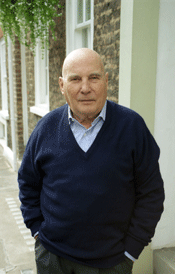Ondine is an excellent herald for the opera, and indeed a year of
interesting Henze events. Phaedra, (2006) will be heard at the Barbican in
London next year, the highlight of a Henze retrospective. In May 2010, the very
latest opera, L’Immolazione premieres in May 2010 at the Accademia di St.
Cecilia in Rome.
Henze has long had a special place in Covent Garden. Ondine was a high
profile commission for a composer still barely 30 years old, and proved to be a
major breakthrough. He’d already made his name in opera. Boulevard
Solitude (1948) his first opera, (heard in a new production at the Royal Opera
House in 2001) is now established repertoire.
Ondine is excellent preparation for next year’s operas. The ballet was
commissioned by Sir Frederick Ashton to showcase Margot Fonteyn. Henze’s
music thus focuses on images of water, tides and waves, for the sea is
Ondine’s element. She’s supernatural, so her music is magically
lyrical. When she dances in the waterfall, the colours in the orchestration
shimmer around her. In comparison, scenes that take place on land, especially
in Act 2, are relatively earthbound, but that’s the essence of the plot.
Palemon dies, but Ondine lives on, immortal.
The music flows so seamlessly into dance that you can almost see semi
quavers enacted in movement. Every note reflects in dance. Pizzicato becomes en
pointe, the interplay of piano, harp, and celeste become intricate ensemble.
The guitar part is more than mere “Italianate colour”, for Henze
loves the instrument and has written more for it than any modern composer.
Seeing Ondine in performance shows just how good a composer Henze was and
is. Sir Frederick Ashton and the audiences of 1958 found the music difficult,
but Henze, a devoted balletomane, wrote intuitively for dance. Now the music
poses no problems. Instead, we can appreciate how it respects the physical
demands of ballet. Despite the undulating, wavering beauty of the scoring there
are firm undercurrents and a strong dramatic pulse.
The water spirits form a circle, their arms undulating, like a giant sea
anemone, moving with the ocean tides. Graceful as the image is, it’s also
powerfully muscular, underlined by the depth and energy of the music. Sea
anemones look delicate, but they’re strong, a lot like ballerinas. I
learned Ondine from the audio recording conducted by Oliver Knussen. Now the
image of the ondines in the corps de ballet will remain with me.
The sets were designed by Lila Di Nobili, who also designed the British
premiere of Elegy for Young Lovers at Glyndebourne in 1961. Sir Frederick
Ashton wanted to pay tribute to 19th century ballet tradition, so the set is
lushly romantic, complete with proscenium arches, like a cherished museum
piece. Against this background, the dancers seem all the more youthful and
vibrant.
Both Ansanelli and Hristov were replacements for scheduled dancers. Given
that these roles were immortalized by Fonteyn and Michael Somes, they did well.
Most impressive, though was Kenta Kura’s Tirrenio. It’s a wonderful
character part, which Kura made wholly convincing. When he leaps on stage, his
costume flowing in the air, he really does seem a powerful, mercurial Lord of
the Mediterranean. The corps was disciplined and energetic. The Royal Opera
House chorus is justly famous for its ensemble work : perhaps sharing
facilities with the Royal Ballet contributes.
In April the Royal Opera House produced an unusual double bill – Handel and
Purcell – but with an added attraction, combining opera with dance.
Ballet and opera audiences don’t mix often enough. Perhaps, given
Henze’s facility for writing for both genres, we’ll see more of his
work in future years.
Anne Ozorio
